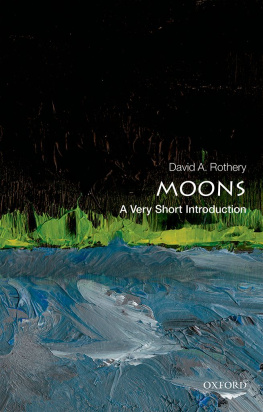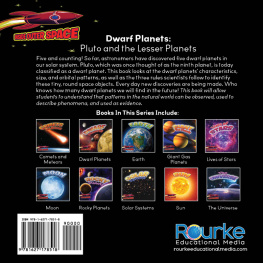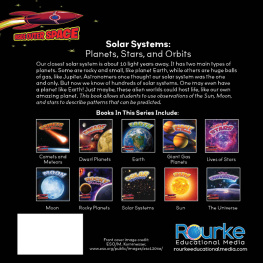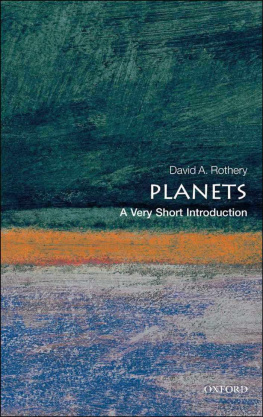COSMOLOGY
A Very Short Introduction
Peter Coles
What happened in the Big Bang? How did galaxies form? Is the universe accelerating? What is dark matter? What caused the ripples in the cosmic microwave background?
These are just some of the questions todays cosmologists are trying to answer. This book is an accesible and non-technical introduction to the history of cosmology and the latest developments in the field. It is the ideal starting point for anyone curious about the universe and how it began.
A delightful and accesible introduction to modern cosmology
Professor J. Silk, Oxford University
a fast track through the history of our endlessly fascinating Universe, from then to now
J. D. Barrow, Cambridge University
www.oup.co.uk/isbn/0-19-285416-X
GLOBAL WARMING
A Very Short Introduction
Mark Maslin
Global Warming is one of the most controversial scientific issues of the twenty-first century. This is a problem that has serious economic, sociological, geopolitical, political, and personal implications.
This Very Short Introduction is an informative, up-to-date, and readable book about the predicted impacts of global warming and the surprises that could be in store for us in the near future. It unpacks the controversies that surround global warming, drawing on material from the recent report of the Intergovernmental Panel on Climate Change (IPCC), and for the first time presents the findings of the Panel for a general readership. The book also discusses what we can do now to adapt to climate change and mitigate its worst effects.
http://www.oup.co.uk/isbn/0-19-284097-5
PARTICLE PHYSICS
A Very Short Introduction
Frank Close
In this compelling introduction to the fundamental particles that make up the universe, Frank Close takes us on a journey into the atom to examine known particles such as quarks, electrons, and the ghostly neutrino. Along the way he provides fascinating insights into how discoveries in particle physics have actually been made, and discusses how our picture of the world has been radically revised in the light of these developments. He concludes by looking ahead to new ideas about the mystery of antimatter, the number of dimensions that there might be in the universe, and to what the next 50 years of research might reveal.
http://www.oup.co.uk/isbn/0-19-280434-0
Chapter 1
The Solar System
Planets in history
Before the curses of light pollution and smog, people were more familiar with the night sky than they tend to be today. Planets in the sky were recognized as special by ancient cultures, because they are wandering stars that migrate against the background of the fixed stars. Five planets have been known since antiquity: Mercury, Venus, Mars, Jupiter, and Saturn which are the only ones bright enough to come to the attention of the unaided eye. Of course, the Sun and Moon were obvious too, but the planets appear as wandering points of light, whereas the Sun and Moon show disks and tended to be regarded differently. Throughout most of humankinds existence, the Earth was imagined to be the centre of creation, unrelated to objects in the sky, so it was not thought of as a planet.
The intellectual leaps that recognized that the Earth is a ball of rock going round the Sun, that the planets do likewise, and that the Earth is just one of their number were a long time coming. The process was slow, and there were many false dawns. During the 5th century BC, the ancient Greek philosopher Anaxagoras correctly surmised that the Moon is a spherical body reflecting the light of the Sun, and he was sent into exile on account of his beliefs. In the succeeding centuries, various Chinese astronomers developed similar ideas, but the idea of the Moon as a globe probably did not embed itself into popular consciousness until its appearance through a telescope became known during the 17th century.
As for the planets, they were generally regarded as points of light going round the Earth, until the counterintuitive heliocentric view with the Sun as the centre of motion became accepted. The earliest written suggestions that the Earth goes round the Sun occur in Indian texts dating from the 9th century BC, but despite this and subsequent independent suggestions, notably by Hellenic and Islamic sages and eventually by Nikolas Copernicus in 1543, the concept did not achieve ascendancy until the 18th century. Partly on account of his advocacy of the heliocentric theory, Galileo Galilei (who through his telescope had seen mountains on the Moon, the phases of Venus, and four tiny moons orbiting Jupiter) was held under house arrest from 1633 until his death in 1642.
Simply by revealing the planets as tiny but discernible discs, whereas the stars remained as points of light, use of the telescope from the start of the 17th century onwards marked planets as fundamentally different to stars, and eased the path to regarding them as worlds comparable to our own. Incidentally, we now know that stars are much bigger than planets, but (except for the Sun) they are so very much more distant that only in a few cases can even the most sophisticated of modern telescopes show any surface details (on photographs, bright stars look bigger than faint stars, but that is just an optical effect the brightness is being smeared out).
Keplers laws of planetary motion
The planets slotted into their rightful place in human comprehension thanks to Johannes Keplers (1609) realization that the planets (including the Earth) travel round the Sun in paths (orbits) that are ellipses rather than perfect circles, coupled with Isaac Newtons (1687) insight into gravity that explained this motion. Then their distances and sizes relative to the Earth could begin to be deduced.
An ellipse is what you might think of as an oval. Mathematically, it is defined as a closed curve drawn about two points (the foci of the ellipse) such that the sum of the distances from each focus to any point on the curve is identical. A circle is a special kind of ellipse in which the two foci coincide, at the circles centre. The further apart the foci, the more elongated, or eccentric, the ellipse. Kepler deduced that planets follow elliptical orbits, with the Sun at one focus of each ellipse (the other focus being empty). The point on an orbit closest to the Sun is called perihelion (Greek for closest to the Sun), and the point furthest away is called aphelion (Greek for furthest from the Sun). Planets orbits are not strongly eccentric, and if you see them drawn in plan view they look very much like circles. For example, when Mars is at aphelion its distance from the Sun is less than 21% greater than when it is at perihelion, and for the Earth the difference is only 4%.
Kepler is justly famous for his three laws of planetary motion. Keplers First Law is simply the statement that each planet moves in an elliptical orbit, with the Sun at one focus. The Second Law describes how the speed of a planet varies around its orbit: a planet moves faster the closer it is to the Sun (for reasons subsequently explained by Newtons theory of gravity) such that an imaginary line linking the planet to the Sun sweeps out an equal area in equal time. Keplers Third Law relates a planets orbital period (how long it takes to complete a circuit round the Sun) to its average distance from the Sun: the cube of the orbital period is proportional to the square of the average distance. The average distance from planet to Sun turns out to be equal to half the length of the orbital ellipses long axis (its semi-major axis) or, if you prefer, half the straightline distance between perihelion and aphelion.









